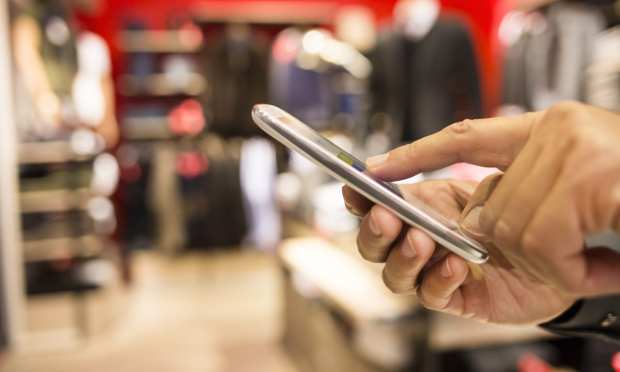Physical And Digital Retail Unite For The New In-Store Experience

“Digital transformation.” The term suggests a permanent departure from the physical, but that’s not the whole of it. As COVID-19 continues to modify ideas around how we shop and pay, consumers and B2B buyers are also making choices about where to shop: online or in-store?
The answer is “both,” but there the simplicity ends. It’s the old story about how we don’t miss something until it’s gone. Like going to the mall, or that favorite pub. The jarring digital shift of 2020 was a disaster recovery scramble that just swept away these most human of behaviors.
Now there are signals that a physical retail rebound is forming up.
With the U.S. presidential election in the rearview mirror and 2021 right around the corner, a new shift is underway: the slow but certain move back to shopping inside retail stores — an experience that people still crave for the experiential joy it brings. But expectations have changed dramatically, and shrewd physical store operators need to respond accordingly.
This is especially true of the biggest spenders with the most disposable income.
“Having digital payment options is even more important to bridge millennials, millennials and members of Generation Z than to the average consumer — and far more important than it is to either Generation X consumers or baby boomers and seniors,” notes the PYMNTS How We Will Shop Report, a collaboration with PayPal. “The payment options merchants accept impact consumers’ willingness to shop in store for 69 percent of bridge millennials, 70 percent of millennials and 71 percent of Gen Z consumers.”
Putting A Premium On Control, Convenience And Safety
Jumping ahead to a post-COVID future while commenting on current pent-up demand for physical experiences, PYMNTS CEO Karen Webster wrote, “The retail success stories of 2022 and beyond will be those that use digital tools to make it more efficient for consumers to get what they need using digital channels, and what they want to buy via a unique and valuable in-store experience.”
It’s a distinction with an important difference, as we learn from The Global Digital Shopping Index, a PYMNTS and Cybersource collaboration. “Our research strongly indicates that the more consumers have been exposed to digital shopping tools, the less patience they seem to have for the frictions that have long accompanied in-store shopping, such as checkout lines and product shortages. The pandemic has undoubtedly exacerbated these tensions. Retailers in this environment must do more to imbue in-store shopping experiences with the sense of control, convenience and safety consumers have come to expect when purchasing online.”
Walmart gets it. That’s one reason the mega-retailer recently did an about-face on retail restocking robots in favor of human workers. Another example is Amazon, whose touchless retail concepts give a good look at in-store experiences to come.
“Of all the ways Amazon has disrupted retail, the one with greatest potential impact may be the Amazon Go store,” wrote Jim Reynolds, group director, senior client partner at digital transformation firm Publicis Sapient.
Reynolds noted that “[People] clearly still love and need a physical store experience. But what they don’t love or need is a checkout line. Amazon Go is more than just a checkout experience; the organization is mining data that will be leveraged to improve merchandizing, store layout, wayfinding, restocking and fulfillment. This is good news for busy shoppers and a wake-up call to the competition — many of whom need to consider their own version of a seamless physical shopping experience.”
It’s a wake-up call that more chains are getting. Rite Aid has unveiled its new store design, saying it a statement, “Rite Aid seeks to deliver a fresh, differentiated experience across all channels with a company strategy targeting Millennial and Gen X women who take care of themselves, their children, aging parents, and even pets.”
Rite Aid said it’s been fine-tuning customer experience all year while “establishing on-trend supplier relationships, delivering new and enhanced training, tools and work processes to all in-store associates, using Lean methodology to free up pharmacists’ time, modernizing … e-commerce infrastructure and online experience, and physically refreshing its fleet of stores.”
Clicks, Bricks And New Retail Tricks
Seamlessly merging the physical and digital is emerging as they key to cracking the new code.
“Retailers who make physical a part of the digital shopping experience can align consumers’ expectations of efficiency and certainty with their interest in using the physical store to shop in new and different ways that go well beyond buying online and picking up in-store,” PYMNTS’ Webster wrote. “As enthusiastic as merchants are to offer that feature, U.S. consumers regard it as much less desirable than delivery, which is their first preference, and curbside pickup, which is second on their list.”
As the new Global Digital Shopping Index notes, “The top performers in the current retail market are not digital marketplaces but rather merchants with both brick-and-mortar and online operations. The largest portion of top-performing merchants, according to our Customer Satisfaction Index, make 50 percent to 75 percent of their sales in-store versus online. Only half as many top performers are found among those who do most of their sales online, and only a fraction of leading merchants sell exclusively in-store.”
Catering to the hybrid digital-physical shopper is becoming an attribute of the top-performing merchants. “Shopping inside stores remains the most common way consumers shop. This does not necessarily mean shoppers like it, however,” per the Global Digital Shopping Index. “Our research indicates that a growing share of consumers appreciate the certainty, efficiency and safety of digital shopping channels and that these feelings are informing the standards and expectations they have for shopping in general.”